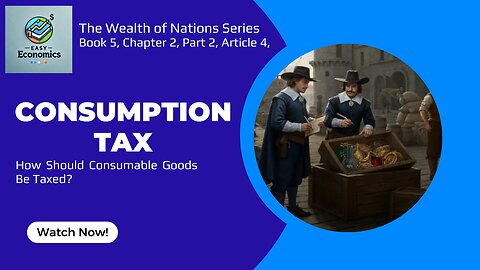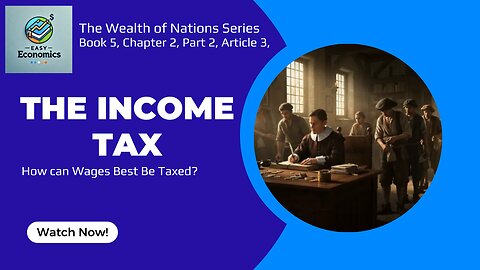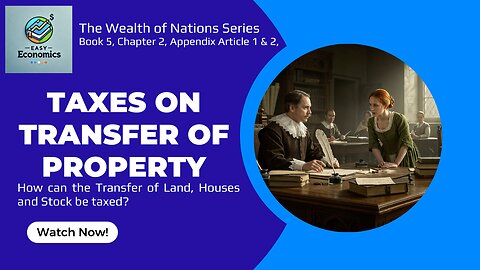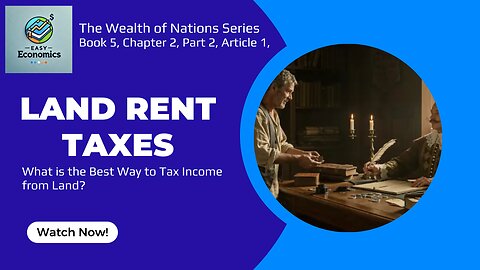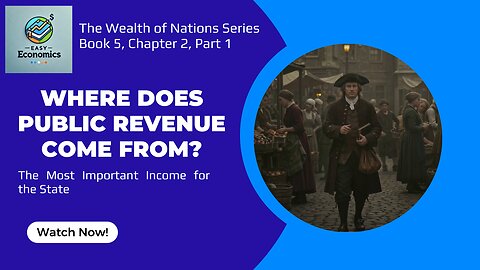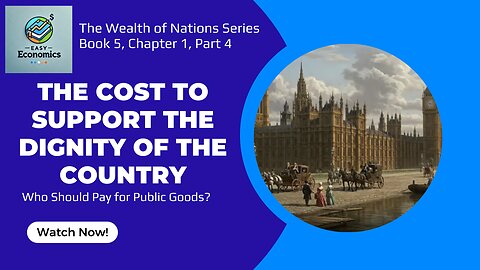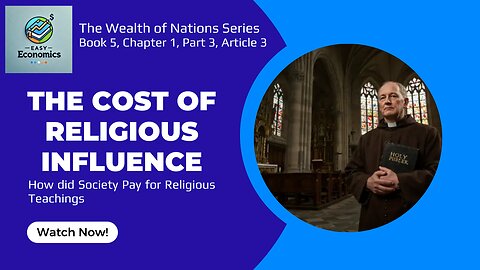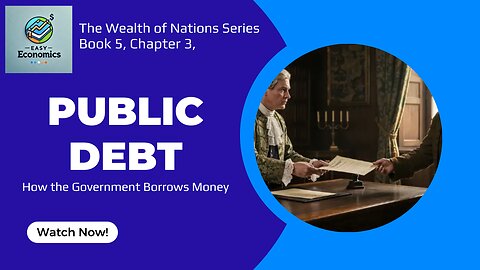
The Wealth of Nations Book 5
13 videos
Updated 9 months ago
Adam Smith’s The Wealth of Nations is famous for its insights into free markets and economic growth, but Book 5 takes a different turn. Here, Smith focuses on the role of government, taxation, public spending, and national defense. He argues that while free markets drive prosperity, the state has key responsibilities—protecting citizens, upholding justice, and maintaining public institutions that private enterprise cannot provide efficiently.
This playlist breaks down Book 5 into clear, easy-to-understand videos. We’ll explore Smith’s views on taxation, the dangers of excessive government intervention, and his warnings about public debt. You’ll see how his ideas shaped modern economics and why they remain relevant today. Whether you're new to The Wealth of Nations or revisiting it with fresh eyes, this series will help you grasp Smith’s final lessons on political economy and the proper role of the state in a free-market system.
-
The Wealth of Nations Book 5 Chapter 1 - Public Debt
 EasyEconomicsGet the original book: https://amzn.to/3W5xeku Learn about The Wealth of Nations on our website: https://easyeconomics.net/video-series-economics-books/the-wealth-of-nations/ Watch our video series about The Wealth of Nations by Adam Smith: https://rumble.com/playlists/bDlhDvvVL8Q Watch our video’s about other economics books: https://rumble.com/playlists/dJGTX0xbi6E Watch the next video in this series: Public debt has shaped the financial and political landscape of modern economies. This video explores how government borrowing began as a way to finance wars and large expenses, but over time became a permanent fixture of national economies. Early rulers rarely borrowed, relying instead on savings. As trade and industry grew, governments began borrowing from wealthy merchants and securing loans with future tax revenues. Britain's debts soared during wars in the 18th century, forcing the government to create permanent taxes to pay loan interest. The sinking fund, designed to reduce debt, was often misused to finance new expenses. Colonial expansion added to the financial strain, and Britain considered taxing the American colonies to share the burden. However, debt-driven funding weakened long-term growth by diverting capital from productive uses. High land taxes and trade tariffs hurt agriculture and industry, while creditors profited from government debt payments without contributing to the economy. Attempts to unify Britain’s tax system with the colonies faced political resistance. This video examines how debt has burdened modern governments and why most nations never fully repay their debts. Questions Answered: -How did early governments finance wars before borrowing became common? -Why did government borrowing increase with the growth of trade and industry? -How did the sinking fund work, and why was it misused? -Why did Britain's debt increase rapidly during the 18th century wars? -How did colonial expansion affect Britain's debt and tax policies? -Why did landowners and businesses struggle under high taxes? -How did funding public debt weaken long-term economic growth? -Why was taxing the American colonies considered necessary for debt repayment? -What role did annuities and tontines play in government borrowing? -Why do most modern governments struggle to repay public debt? 00:00 - Introduction to Public Debt 00:12 - Early Societies 00:44 - Growth of Commerce 01:38 - European National Debts 02:18 - British Government Taxes 03:10 - Interest Rates 04:01 - Wars of 1739 and 1755 04:59 - Britain’s Public Debt 05:52 - Mr. Pelham's Administration 07:12 - Britain’s Growing Debt 07:44 - War Debt 08:48 - Funding 09:24 - Britain’s Tax System 10:07 - National Debts 10:46 - Devaluing Currency 11:43 - British-Style Taxes 12:19 - British Excise Tax System 13:05 - Sugar, Rum, and Tobacco 13:58 - Revenue Growth 15:02 - Foreign Trade 15:34 - Sugar Colonies 16:41 - Lack of Gold and Silver 17:15 - Ireland and America 18:00 - Colonies 18:34 - Taxes 19:42 - Conclusion #PublicDebt #GovernmentBorrowing #EconomicHistory11 views
EasyEconomicsGet the original book: https://amzn.to/3W5xeku Learn about The Wealth of Nations on our website: https://easyeconomics.net/video-series-economics-books/the-wealth-of-nations/ Watch our video series about The Wealth of Nations by Adam Smith: https://rumble.com/playlists/bDlhDvvVL8Q Watch our video’s about other economics books: https://rumble.com/playlists/dJGTX0xbi6E Watch the next video in this series: Public debt has shaped the financial and political landscape of modern economies. This video explores how government borrowing began as a way to finance wars and large expenses, but over time became a permanent fixture of national economies. Early rulers rarely borrowed, relying instead on savings. As trade and industry grew, governments began borrowing from wealthy merchants and securing loans with future tax revenues. Britain's debts soared during wars in the 18th century, forcing the government to create permanent taxes to pay loan interest. The sinking fund, designed to reduce debt, was often misused to finance new expenses. Colonial expansion added to the financial strain, and Britain considered taxing the American colonies to share the burden. However, debt-driven funding weakened long-term growth by diverting capital from productive uses. High land taxes and trade tariffs hurt agriculture and industry, while creditors profited from government debt payments without contributing to the economy. Attempts to unify Britain’s tax system with the colonies faced political resistance. This video examines how debt has burdened modern governments and why most nations never fully repay their debts. Questions Answered: -How did early governments finance wars before borrowing became common? -Why did government borrowing increase with the growth of trade and industry? -How did the sinking fund work, and why was it misused? -Why did Britain's debt increase rapidly during the 18th century wars? -How did colonial expansion affect Britain's debt and tax policies? -Why did landowners and businesses struggle under high taxes? -How did funding public debt weaken long-term economic growth? -Why was taxing the American colonies considered necessary for debt repayment? -What role did annuities and tontines play in government borrowing? -Why do most modern governments struggle to repay public debt? 00:00 - Introduction to Public Debt 00:12 - Early Societies 00:44 - Growth of Commerce 01:38 - European National Debts 02:18 - British Government Taxes 03:10 - Interest Rates 04:01 - Wars of 1739 and 1755 04:59 - Britain’s Public Debt 05:52 - Mr. Pelham's Administration 07:12 - Britain’s Growing Debt 07:44 - War Debt 08:48 - Funding 09:24 - Britain’s Tax System 10:07 - National Debts 10:46 - Devaluing Currency 11:43 - British-Style Taxes 12:19 - British Excise Tax System 13:05 - Sugar, Rum, and Tobacco 13:58 - Revenue Growth 15:02 - Foreign Trade 15:34 - Sugar Colonies 16:41 - Lack of Gold and Silver 17:15 - Ireland and America 18:00 - Colonies 18:34 - Taxes 19:42 - Conclusion #PublicDebt #GovernmentBorrowing #EconomicHistory11 views -
The Wealth of Nations Book 5 Chapter 2 Part 2 Article 4 - Taxes on Consumable Goods
 EasyEconomicsGet the original book: https://amzn.to/3W5xeku Learn about The Wealth of Nations on our website: https://easyeconomics.net/video-series-economics-books/the-wealth-of-nations/ Watch our video series about The Wealth of Nations by Adam Smith: https://rumble.com/playlists/bDlhDvvVL8Q Watch our video’s about other economics books: https://rumble.com/playlists/dJGTX0xbi6E Watch the next video in this series: Taxes on income, property, and goods have shaped economies and social structures for centuries. This video explores how different types of taxes—capitation taxes, consumption taxes, and trade tariffs—affect people and economies. Capitation taxes, or head taxes, fall unfairly on poorer citizens when based on rank or perceived wealth, as seen in France and England. Taxes on consumable goods, like salt and tobacco, raise living costs and wages, which then push up product prices and lower land rents. Luxury taxes are more accepted since they target optional spending, but excise and import duties have unintended consequences, encouraging smuggling and raising costs for local producers. Britain’s simpler tax system boosts trade and revenue, while France’s complex, corruption-ridden system creates economic inefficiencies. Private tax farming in France increases costs and harsh enforcement, especially for salt and tobacco. High trade tariffs protect domestic industries but also reduce trade and encourage smuggling. The Dutch and Italian tax systems face similar challenges, with high costs and complex rules hurting local industries. Understanding how these taxes work—and why some systems succeed while others fail—helps explain modern economic policies and their impact on wealth, trade, and social stability. Questions Answered: How do capitation taxes affect different social classes? Why do luxury taxes have less economic impact than taxes on necessities? How does Britain’s tax system differ from France’s? Why do high import tariffs encourage smuggling? What role does tax farming play in raising revenue? How do excise taxes affect domestic production costs? Why do high taxes on essentials raise wages and product prices? How did the salt and tobacco monopolies impact French society? Why do trade barriers harm domestic production and exports? How could France simplify its tax system to raise more revenue? 00:00 - Introduction to Consumption Tax 00:17 - Taxes on Income 01:20 - Taxes on Consumable Goods 02:19 - Impact of Taxes on Necessities 03:22 - Methods of Taxing Goods 04:12 - Excise Taxes and Customs Duties 04:59 - The Mercantile System 06:24 - Controlling Smuggling 07:05 - Maximizing Revenue 07:50 - Political Opposition 09:17 - Taxes on Malt and Spirits 09:56 - Dr. Davenant’s Objections 10:39 - Impact on Barley Demand 11:41- Luxury Taxes 12:36 - Downsides of Taxes on Goods 13:30 - Political Justification 14:39 - Britain’s Tax System 15:31 - Other European Countries 16:21 - France’s Tax System 17:50 - Britain vs. France 18:45 - Conclusion #Taxation #TradeBarriers #EconomicPolicy21 views
EasyEconomicsGet the original book: https://amzn.to/3W5xeku Learn about The Wealth of Nations on our website: https://easyeconomics.net/video-series-economics-books/the-wealth-of-nations/ Watch our video series about The Wealth of Nations by Adam Smith: https://rumble.com/playlists/bDlhDvvVL8Q Watch our video’s about other economics books: https://rumble.com/playlists/dJGTX0xbi6E Watch the next video in this series: Taxes on income, property, and goods have shaped economies and social structures for centuries. This video explores how different types of taxes—capitation taxes, consumption taxes, and trade tariffs—affect people and economies. Capitation taxes, or head taxes, fall unfairly on poorer citizens when based on rank or perceived wealth, as seen in France and England. Taxes on consumable goods, like salt and tobacco, raise living costs and wages, which then push up product prices and lower land rents. Luxury taxes are more accepted since they target optional spending, but excise and import duties have unintended consequences, encouraging smuggling and raising costs for local producers. Britain’s simpler tax system boosts trade and revenue, while France’s complex, corruption-ridden system creates economic inefficiencies. Private tax farming in France increases costs and harsh enforcement, especially for salt and tobacco. High trade tariffs protect domestic industries but also reduce trade and encourage smuggling. The Dutch and Italian tax systems face similar challenges, with high costs and complex rules hurting local industries. Understanding how these taxes work—and why some systems succeed while others fail—helps explain modern economic policies and their impact on wealth, trade, and social stability. Questions Answered: How do capitation taxes affect different social classes? Why do luxury taxes have less economic impact than taxes on necessities? How does Britain’s tax system differ from France’s? Why do high import tariffs encourage smuggling? What role does tax farming play in raising revenue? How do excise taxes affect domestic production costs? Why do high taxes on essentials raise wages and product prices? How did the salt and tobacco monopolies impact French society? Why do trade barriers harm domestic production and exports? How could France simplify its tax system to raise more revenue? 00:00 - Introduction to Consumption Tax 00:17 - Taxes on Income 01:20 - Taxes on Consumable Goods 02:19 - Impact of Taxes on Necessities 03:22 - Methods of Taxing Goods 04:12 - Excise Taxes and Customs Duties 04:59 - The Mercantile System 06:24 - Controlling Smuggling 07:05 - Maximizing Revenue 07:50 - Political Opposition 09:17 - Taxes on Malt and Spirits 09:56 - Dr. Davenant’s Objections 10:39 - Impact on Barley Demand 11:41- Luxury Taxes 12:36 - Downsides of Taxes on Goods 13:30 - Political Justification 14:39 - Britain’s Tax System 15:31 - Other European Countries 16:21 - France’s Tax System 17:50 - Britain vs. France 18:45 - Conclusion #Taxation #TradeBarriers #EconomicPolicy21 views -
The Wealth of Nations Book 5 Chapter 2 Part 2 Article 3 - Taxes on Wages
 EasyEconomicsGet the original book: https://amzn.to/3W5xeku Learn about The Wealth of Nations on our website: https://easyeconomics.net/video-series-economics-books/the-wealth-of-nations/ Watch our video series about The Wealth of Nations by Adam Smith: https://rumble.com/playlists/bDlhDvvVL8Q Watch our video’s about other economics books: https://rumble.com/playlists/dJGTX0xbi6E Watch the next video in this series: Taxes on labor have long shaped economies and labor markets. This video explores how taxes on wages affect both workers and employers. When governments impose direct taxes on wages, workers often demand higher pay to cover the tax, which drives up production costs and consumer prices. In agriculture, landowners bear the cost as farmers retain more of the crop’s value to cover increased wages. If higher wages aren’t possible, labor demand falls, leading to lower employment and reduced economic activity. Historical examples from France’s taille tax and Bohemia’s labor tax highlight how governments have imposed and adjusted wage taxes over centuries. Skilled workers face different pressures since higher taxes drive them to less-taxed trades, pushing wages up further. Public sector wages, however, are set by government decisions rather than market forces, leading to overpayment in some cases. Taxing government salaries has often been more politically acceptable than taxing labor directly. From the agricultural sector to skilled trades, this video breaks down how taxing wages impacts the economy, employment, and living costs. Questions Answered: How do taxes on wages affect labor costs and wages? Why do employers pass the cost of wage taxes to consumers and landowners? What happens when wage taxes reduce labor demand? How did France's taille tax work? How did Bohemia’s labor tax affect artisans? Why do taxes on skilled labor increase wages further? How do wage taxes influence unemployment? Why are taxes on government salaries often more accepted? How do taxes on agricultural labor affect land rents? What’s the difference between taxing skilled labor and taxing government wages? 00:00 - Introduction to Taxes on Labour 00:11 - Wages and Taxes 00:40 - Impact on Employers 01:03 - Taxes and Demand for Labor 01:24 - Historical Examples 01:50 - Taxes on Skilled Workers 02:27 - Conclusion #LaborTaxes #Wages #EconomicImpact9 views
EasyEconomicsGet the original book: https://amzn.to/3W5xeku Learn about The Wealth of Nations on our website: https://easyeconomics.net/video-series-economics-books/the-wealth-of-nations/ Watch our video series about The Wealth of Nations by Adam Smith: https://rumble.com/playlists/bDlhDvvVL8Q Watch our video’s about other economics books: https://rumble.com/playlists/dJGTX0xbi6E Watch the next video in this series: Taxes on labor have long shaped economies and labor markets. This video explores how taxes on wages affect both workers and employers. When governments impose direct taxes on wages, workers often demand higher pay to cover the tax, which drives up production costs and consumer prices. In agriculture, landowners bear the cost as farmers retain more of the crop’s value to cover increased wages. If higher wages aren’t possible, labor demand falls, leading to lower employment and reduced economic activity. Historical examples from France’s taille tax and Bohemia’s labor tax highlight how governments have imposed and adjusted wage taxes over centuries. Skilled workers face different pressures since higher taxes drive them to less-taxed trades, pushing wages up further. Public sector wages, however, are set by government decisions rather than market forces, leading to overpayment in some cases. Taxing government salaries has often been more politically acceptable than taxing labor directly. From the agricultural sector to skilled trades, this video breaks down how taxing wages impacts the economy, employment, and living costs. Questions Answered: How do taxes on wages affect labor costs and wages? Why do employers pass the cost of wage taxes to consumers and landowners? What happens when wage taxes reduce labor demand? How did France's taille tax work? How did Bohemia’s labor tax affect artisans? Why do taxes on skilled labor increase wages further? How do wage taxes influence unemployment? Why are taxes on government salaries often more accepted? How do taxes on agricultural labor affect land rents? What’s the difference between taxing skilled labor and taxing government wages? 00:00 - Introduction to Taxes on Labour 00:11 - Wages and Taxes 00:40 - Impact on Employers 01:03 - Taxes and Demand for Labor 01:24 - Historical Examples 01:50 - Taxes on Skilled Workers 02:27 - Conclusion #LaborTaxes #Wages #EconomicImpact9 views -
The Wealth of Nations Book Chapter 2 Appendix Article 1 & 2 - Taxes on Property Transfers
 EasyEconomicsGet the original book: https://amzn.to/3W5xeku Learn about The Wealth of Nations on our website: https://easyeconomics.net/video-series-economics-books/the-wealth-of-nations/ Watch our video series about The Wealth of Nations by Adam Smith: https://rumble.com/playlists/bDlhDvvVL8Q Watch our video’s about other economics books: https://rumble.com/playlists/dJGTX0xbi6E Watch the next video in this series: Taxes on property transfers have existed for centuries, affecting land, houses, and financial assets. This video explores how governments have historically taxed property transfers, from ancient Rome’s inheritance taxes under Augustus to feudal fees on land inheritance and modern stamp and registration duties. We examine how these taxes shift the financial burden between buyers and sellers, why some taxes fall harder on certain groups, and how corruption and inefficiency have influenced tax collection in France and the Netherlands. You'll also learn how taxes on new homes, old homes, and rental properties affect prices and who ultimately pays the cost. From feudal land inheritance to modern real estate taxes, understanding these transfer taxes helps explain why property ownership remains a costly and often unequal process. Whether you're curious about the history of taxation or how modern property taxes work, this video covers the key principles and challenges behind taxing property transfers. Questions Answered: How did ancient Rome tax property transfers and inheritances? Why were feudal heirs required to pay fees to inherit land? How do modern stamp and registration duties work? Why do transfer taxes often burden sellers more than buyers? How do transfer taxes differ between the Netherlands, France, and Britain? Why are taxes on new houses usually paid by buyers? How have corrupt practices affected registration taxes in France? What are the effects of transfer taxes on investment and property values? Why are secret registers linked to fraud and tax evasion? How do taxes on consumer goods compare to property transfer taxes? 00:00 - Introduction about Taxes on the Transfer of Property 00:16 - Historical Context of Property Taxes 00:34 - Methods of Taxing Transfers 01:11 - Feudal Law and Land Inheritance 01:37 - Modern European Tax Systems 02:01 - Economic Effects of Transfer Taxes 02:28 - Issues with Stamp and Registration Taxes 02:56 - Historical Context of Property Taxes (Repeated) 03:15 - Methods of Taxing Transfers (Repeated) 03:51 - Feudal Law and Land Inheritance (Repeated) 04:18 - Modern European Tax Systems (Repeated) 04:42 - Economic Effects of Transfer Taxes (Repeated) 05:09 - Issues with Stamp and Registration Taxes (Repeated) 05:56 - Outro #PropertyTaxes #InheritanceTax #RealEstate16 views 1 comment
EasyEconomicsGet the original book: https://amzn.to/3W5xeku Learn about The Wealth of Nations on our website: https://easyeconomics.net/video-series-economics-books/the-wealth-of-nations/ Watch our video series about The Wealth of Nations by Adam Smith: https://rumble.com/playlists/bDlhDvvVL8Q Watch our video’s about other economics books: https://rumble.com/playlists/dJGTX0xbi6E Watch the next video in this series: Taxes on property transfers have existed for centuries, affecting land, houses, and financial assets. This video explores how governments have historically taxed property transfers, from ancient Rome’s inheritance taxes under Augustus to feudal fees on land inheritance and modern stamp and registration duties. We examine how these taxes shift the financial burden between buyers and sellers, why some taxes fall harder on certain groups, and how corruption and inefficiency have influenced tax collection in France and the Netherlands. You'll also learn how taxes on new homes, old homes, and rental properties affect prices and who ultimately pays the cost. From feudal land inheritance to modern real estate taxes, understanding these transfer taxes helps explain why property ownership remains a costly and often unequal process. Whether you're curious about the history of taxation or how modern property taxes work, this video covers the key principles and challenges behind taxing property transfers. Questions Answered: How did ancient Rome tax property transfers and inheritances? Why were feudal heirs required to pay fees to inherit land? How do modern stamp and registration duties work? Why do transfer taxes often burden sellers more than buyers? How do transfer taxes differ between the Netherlands, France, and Britain? Why are taxes on new houses usually paid by buyers? How have corrupt practices affected registration taxes in France? What are the effects of transfer taxes on investment and property values? Why are secret registers linked to fraud and tax evasion? How do taxes on consumer goods compare to property transfer taxes? 00:00 - Introduction about Taxes on the Transfer of Property 00:16 - Historical Context of Property Taxes 00:34 - Methods of Taxing Transfers 01:11 - Feudal Law and Land Inheritance 01:37 - Modern European Tax Systems 02:01 - Economic Effects of Transfer Taxes 02:28 - Issues with Stamp and Registration Taxes 02:56 - Historical Context of Property Taxes (Repeated) 03:15 - Methods of Taxing Transfers (Repeated) 03:51 - Feudal Law and Land Inheritance (Repeated) 04:18 - Modern European Tax Systems (Repeated) 04:42 - Economic Effects of Transfer Taxes (Repeated) 05:09 - Issues with Stamp and Registration Taxes (Repeated) 05:56 - Outro #PropertyTaxes #InheritanceTax #RealEstate16 views 1 comment -
The Wealth of Nations Book 5 Chapter 2 Part 2 Article 2 - Taxes on Profits of Stock
 EasyEconomicsGet the original book: https://amzn.to/3W5xeku Learn about The Wealth of Nations on our website: https://easyeconomics.net/video-series-economics-books/the-wealth-of-nations/ Watch our video series about The Wealth of Nations by Adam Smith: https://rumble.com/playlists/bDlhDvvVL8Q Watch our video’s about other economics books: https://rumble.com/playlists/dJGTX0xbi6E Watch the next video in this series: How do governments tax profits from stock — and who really ends up paying? In this video, we’ll explore how taxes on business profits, interest, and stock work, and why they often shift the burden to consumers, investors, or landowners. We’ll explain why taxing surplus profit is difficult since businesses can raise prices or reduce interest payments to cover the cost. You'll learn why taxing stock is harder than taxing land — stock is mobile and harder to track, while land is fixed and easier to assess. We’ll also cover how different countries, like England, France, and Holland, have tried to tax profits with mixed success. France’s "taille" tax system on agricultural stock was unpredictable and often unfair, while Holland’s wealth tax worked briefly but couldn't be sustained long-term. We’ll also explore how business taxes, like those on licenses and shop owners, are usually passed to consumers through higher prices. Finally, we’ll discuss why taxing agricultural profits lowers rents rather than raising food prices and why taxes on enslaved laborers functioned similarly to agricultural stock taxes in colonial economies. Find out why taxing profits is complex — and why governments often fail to do it fairly. Questions answered in the video: What are the two components of profit from stock? Why is taxing surplus profit difficult? How does taxing stock differ from taxing land? Why do businesses pass profit taxes to consumers? How did England and France tax business profits differently? Why did France’s "taille" tax system cause problems for farmers? How do agricultural taxes reduce rents rather than increase food prices? Why did Holland’s wealth tax work temporarily but not long-term? How do business licenses and trade taxes affect consumer prices? Why do taxes on enslaved laborers resemble agricultural stock taxes? 00:00 - Introduction to Taxes on the Profit of Stock 00:14 - Profits from Stock 00:56 - Interest on Money 01:36 - Countries that have tried taxing stock profits 02:16 - Hamburg, Zurich and Underwald 02:49 - Taxes in Holland 03:13 - England’s stock tax 03:33 - Taxes on specific industries 04:08 - A tax on business profits 04:52 - Taxes on Profits in France 05:36 - The French personal taille 06:12 - Taxes on profits from trade 06:41 - Farmers in France 07:23 - Household servant taxes 07:47 - Taxes on business profits 08:21 - Outro #ProfitTax #EconomicPolicy #Taxation9 views 1 comment
EasyEconomicsGet the original book: https://amzn.to/3W5xeku Learn about The Wealth of Nations on our website: https://easyeconomics.net/video-series-economics-books/the-wealth-of-nations/ Watch our video series about The Wealth of Nations by Adam Smith: https://rumble.com/playlists/bDlhDvvVL8Q Watch our video’s about other economics books: https://rumble.com/playlists/dJGTX0xbi6E Watch the next video in this series: How do governments tax profits from stock — and who really ends up paying? In this video, we’ll explore how taxes on business profits, interest, and stock work, and why they often shift the burden to consumers, investors, or landowners. We’ll explain why taxing surplus profit is difficult since businesses can raise prices or reduce interest payments to cover the cost. You'll learn why taxing stock is harder than taxing land — stock is mobile and harder to track, while land is fixed and easier to assess. We’ll also cover how different countries, like England, France, and Holland, have tried to tax profits with mixed success. France’s "taille" tax system on agricultural stock was unpredictable and often unfair, while Holland’s wealth tax worked briefly but couldn't be sustained long-term. We’ll also explore how business taxes, like those on licenses and shop owners, are usually passed to consumers through higher prices. Finally, we’ll discuss why taxing agricultural profits lowers rents rather than raising food prices and why taxes on enslaved laborers functioned similarly to agricultural stock taxes in colonial economies. Find out why taxing profits is complex — and why governments often fail to do it fairly. Questions answered in the video: What are the two components of profit from stock? Why is taxing surplus profit difficult? How does taxing stock differ from taxing land? Why do businesses pass profit taxes to consumers? How did England and France tax business profits differently? Why did France’s "taille" tax system cause problems for farmers? How do agricultural taxes reduce rents rather than increase food prices? Why did Holland’s wealth tax work temporarily but not long-term? How do business licenses and trade taxes affect consumer prices? Why do taxes on enslaved laborers resemble agricultural stock taxes? 00:00 - Introduction to Taxes on the Profit of Stock 00:14 - Profits from Stock 00:56 - Interest on Money 01:36 - Countries that have tried taxing stock profits 02:16 - Hamburg, Zurich and Underwald 02:49 - Taxes in Holland 03:13 - England’s stock tax 03:33 - Taxes on specific industries 04:08 - A tax on business profits 04:52 - Taxes on Profits in France 05:36 - The French personal taille 06:12 - Taxes on profits from trade 06:41 - Farmers in France 07:23 - Household servant taxes 07:47 - Taxes on business profits 08:21 - Outro #ProfitTax #EconomicPolicy #Taxation9 views 1 comment -
The Wealth of Nations Book 5 Chapter 2 Part 2 Article 1 - Taxes on the Rent of Land
 EasyEconomicsGet the original book: https://amzn.to/3W5xeku Learn about The Wealth of Nations on our website: https://easyeconomics.net/video-series-economics-books/the-wealth-of-nations/ Watch our video series about The Wealth of Nations by Adam Smith: https://rumble.com/playlists/bDlhDvvVL8Q Watch our video’s about other economics books: https://rumble.com/playlists/dJGTX0xbi6E Watch the next video in this series: How do taxes on land and house rent work — and who really pays them? In this video, we explore how land and house rent have been taxed throughout history and how these taxes impact landlords, tenants, and the broader economy. We'll break down the four key principles of effective taxation: fairness, predictability, convenience, and minimal economic disruption. You'll learn why land taxes in Britain have become unfair over time and how Venice’s adjustable land tax model could solve this issue. We’ll also cover how production-based land taxes in places like China and Bengal encouraged infrastructure improvements — while church tithes in Europe discouraged agricultural development. House rent is split into building rent and ground rent, with taxes on building rent affecting construction while taxes on ground rent reflect state-created value. Find out why taxing ground rent is seen as more just and why past house taxes like the window tax and hearth tax were so unpopular. Finally, we’ll discuss why flexible, well-designed taxes could encourage both land improvement and greater economic growth. Questions answered in the video: What are the four key principles of effective taxation? Why have land taxes in Britain become outdated and unfair? How did Venice’s flexible land tax work better than Britain’s fixed model? Why did production-based land taxes succeed in China and Bengal? How do taxes on house rent affect landlords and tenants differently? What’s the difference between building rent and ground rent? Why is taxing ground rent seen as more just than taxing building rent? How did the hearth tax and window tax affect housing demand in England? How can a flexible land tax encourage land improvements? Why is taxing church land and noble land different from private land? 00:00 - Introduction to Taxes on Rent of Land 00:14 - Sources of Private Income 00:31 - Key Principles for Good Taxation 01:19 - Land Tax 01:49 - Flexible Land Tax 02:41 - Fair and Well-Managed Taxation 03:02 - Variable Land Tax 03:57 - Permanent Part of State Policy 04:36 - Land Tax in Prussia 04:57 - Taxes on Crop Production 05:55 - Taxes on Land Production 06:41 - Rent of a House 07:14 - Ground Rent 07:37 - Tax on House Rent 08:14 - Wealthier Tenants 08:35 - House Rent 08:57 - Taxes on Unoccupied Houses 09:24 - Ground Rent for Taxation 09:53 - Ground Rent is Rarely Taxed 10:20 - Past House Taxes in England 11:00 - Outro #LandTax #EconomicPolicy #PublicRevenue10 views
EasyEconomicsGet the original book: https://amzn.to/3W5xeku Learn about The Wealth of Nations on our website: https://easyeconomics.net/video-series-economics-books/the-wealth-of-nations/ Watch our video series about The Wealth of Nations by Adam Smith: https://rumble.com/playlists/bDlhDvvVL8Q Watch our video’s about other economics books: https://rumble.com/playlists/dJGTX0xbi6E Watch the next video in this series: How do taxes on land and house rent work — and who really pays them? In this video, we explore how land and house rent have been taxed throughout history and how these taxes impact landlords, tenants, and the broader economy. We'll break down the four key principles of effective taxation: fairness, predictability, convenience, and minimal economic disruption. You'll learn why land taxes in Britain have become unfair over time and how Venice’s adjustable land tax model could solve this issue. We’ll also cover how production-based land taxes in places like China and Bengal encouraged infrastructure improvements — while church tithes in Europe discouraged agricultural development. House rent is split into building rent and ground rent, with taxes on building rent affecting construction while taxes on ground rent reflect state-created value. Find out why taxing ground rent is seen as more just and why past house taxes like the window tax and hearth tax were so unpopular. Finally, we’ll discuss why flexible, well-designed taxes could encourage both land improvement and greater economic growth. Questions answered in the video: What are the four key principles of effective taxation? Why have land taxes in Britain become outdated and unfair? How did Venice’s flexible land tax work better than Britain’s fixed model? Why did production-based land taxes succeed in China and Bengal? How do taxes on house rent affect landlords and tenants differently? What’s the difference between building rent and ground rent? Why is taxing ground rent seen as more just than taxing building rent? How did the hearth tax and window tax affect housing demand in England? How can a flexible land tax encourage land improvements? Why is taxing church land and noble land different from private land? 00:00 - Introduction to Taxes on Rent of Land 00:14 - Sources of Private Income 00:31 - Key Principles for Good Taxation 01:19 - Land Tax 01:49 - Flexible Land Tax 02:41 - Fair and Well-Managed Taxation 03:02 - Variable Land Tax 03:57 - Permanent Part of State Policy 04:36 - Land Tax in Prussia 04:57 - Taxes on Crop Production 05:55 - Taxes on Land Production 06:41 - Rent of a House 07:14 - Ground Rent 07:37 - Tax on House Rent 08:14 - Wealthier Tenants 08:35 - House Rent 08:57 - Taxes on Unoccupied Houses 09:24 - Ground Rent for Taxation 09:53 - Ground Rent is Rarely Taxed 10:20 - Past House Taxes in England 11:00 - Outro #LandTax #EconomicPolicy #PublicRevenue10 views -
The Wealth of Nations Book 5 Chapter 2 Part 1 - Exploring Public Revenue Sources
 EasyEconomicsGet the original book: https://amzn.to/3W5xeku Learn about The Wealth of Nations on our website: https://easyeconomics.net/video-series-economics-books/the-wealth-of-nations/ Watch our video series about The Wealth of Nations by Adam Smith: https://rumble.com/playlists/bDlhDvvVL8Q Watch our video’s about other economics books: https://rumble.com/playlists/dJGTX0xbi6E Watch the next video in this series: Where do governments get their money from? In this video, we explore the sources of public revenue that fund government expenses like defense and administration. Historically, governments have relied on two main sources of income: state-owned assets and taxes. We’ll look at examples of governments earning money from trade, banking, and lending — from Venice’s public bank to Hamburg’s public wine cellar. While some state-run businesses, like the post office, have been successful, many others have failed due to mismanagement and inefficiency — as seen with the East India Company. We'll also cover the historical importance of land rents in ancient Greece, Rome, and medieval Europe and why modern governments have shifted toward taxes as their primary source of income. Finally, we'll discuss why selling public land could increase long-term revenue and encourage better private management. Find out why taxes have become the backbone of government funding and why relying on state-owned assets may not be the solution governments hope for. Questions answered in the video: What are the two main sources of public revenue? How have governments historically generated revenue from state assets? Why did public banks succeed in Venice and Amsterdam but fail elsewhere? Why is the post office one of the few successful state-run businesses? How did medieval European monarchs fund their governments? Why are land rents less important in modern economies? What are the risks of relying on government-owned stock and land for revenue? How could selling public land improve government finances? Why have modern governments turned to taxes as their main revenue source? How do state-owned businesses lead to mismanagement and waste? 00:00 - Introduction to the Video about the revenue that funds the Government 00:24 - Income from State Assets 00:53 - Examples of Public Revenue 01:17 - State-Run Businesses 01:48 - How Governments make Revenue 02:25 - Pennsylvania’s Paper Money 02:47 - Ancient Greece and Rome and Monarchs' Income 03:06 - Modern Reliance on Taxes VS Selling Public Land 03:44 - Productive Land and Taxes 04:14 - Outro #PublicRevenue #EconomicHistory #GovernmentFinance8 views
EasyEconomicsGet the original book: https://amzn.to/3W5xeku Learn about The Wealth of Nations on our website: https://easyeconomics.net/video-series-economics-books/the-wealth-of-nations/ Watch our video series about The Wealth of Nations by Adam Smith: https://rumble.com/playlists/bDlhDvvVL8Q Watch our video’s about other economics books: https://rumble.com/playlists/dJGTX0xbi6E Watch the next video in this series: Where do governments get their money from? In this video, we explore the sources of public revenue that fund government expenses like defense and administration. Historically, governments have relied on two main sources of income: state-owned assets and taxes. We’ll look at examples of governments earning money from trade, banking, and lending — from Venice’s public bank to Hamburg’s public wine cellar. While some state-run businesses, like the post office, have been successful, many others have failed due to mismanagement and inefficiency — as seen with the East India Company. We'll also cover the historical importance of land rents in ancient Greece, Rome, and medieval Europe and why modern governments have shifted toward taxes as their primary source of income. Finally, we'll discuss why selling public land could increase long-term revenue and encourage better private management. Find out why taxes have become the backbone of government funding and why relying on state-owned assets may not be the solution governments hope for. Questions answered in the video: What are the two main sources of public revenue? How have governments historically generated revenue from state assets? Why did public banks succeed in Venice and Amsterdam but fail elsewhere? Why is the post office one of the few successful state-run businesses? How did medieval European monarchs fund their governments? Why are land rents less important in modern economies? What are the risks of relying on government-owned stock and land for revenue? How could selling public land improve government finances? Why have modern governments turned to taxes as their main revenue source? How do state-owned businesses lead to mismanagement and waste? 00:00 - Introduction to the Video about the revenue that funds the Government 00:24 - Income from State Assets 00:53 - Examples of Public Revenue 01:17 - State-Run Businesses 01:48 - How Governments make Revenue 02:25 - Pennsylvania’s Paper Money 02:47 - Ancient Greece and Rome and Monarchs' Income 03:06 - Modern Reliance on Taxes VS Selling Public Land 03:44 - Productive Land and Taxes 04:14 - Outro #PublicRevenue #EconomicHistory #GovernmentFinance8 views -
The Wealth of Nations Book 5 Chapter 1 Part 4 - Who Should Pay for Public Cost?
 EasyEconomicsGet the original book: https://amzn.to/3W5xeku Learn about The Wealth of Nations on our website: https://easyeconomics.net/video-series-economics-books/the-wealth-of-nations/ Watch our video series about The Wealth of Nations by Adam Smith: https://rumble.com/playlists/bDlhDvvVL8Q Watch our video’s about other economics books: https://rumble.com/playlists/dJGTX0xbi6E Watch the next video in this series: Who should pay for public services like defense, justice, and infrastructure? This video explores how governments should distribute the costs of essential services. National defense and the justice system benefit society as a whole, so it makes sense to fund them through general taxes. However, when individuals directly benefit from services like education or road use, direct payments or fees may be fairer. Should travelers and merchants pay tolls? Should students cover the costs of education? This video examines how to balance fairness and efficiency when funding public services. Questions Answered: Who should pay for national defense and the justice system? Should local services be funded through general taxes or local fees? Are tolls and road fees fair for travelers and merchants? Should education be funded by taxes or student fees? When should general tax revenue cover public services? 00:00 - Introduction to the video 00:04 - Introduction to Public Costs and Who Should Pay Them 00:10 - National Defense and Justice System 00:43 - Local Expenses and Transportation Networks 01:16 - Education, Religious Instruction, and Government Funding 01:49 - Government Revenue and Conclusion Hashtags: #PublicFunding #Taxation #GovernmentSpending6 views
EasyEconomicsGet the original book: https://amzn.to/3W5xeku Learn about The Wealth of Nations on our website: https://easyeconomics.net/video-series-economics-books/the-wealth-of-nations/ Watch our video series about The Wealth of Nations by Adam Smith: https://rumble.com/playlists/bDlhDvvVL8Q Watch our video’s about other economics books: https://rumble.com/playlists/dJGTX0xbi6E Watch the next video in this series: Who should pay for public services like defense, justice, and infrastructure? This video explores how governments should distribute the costs of essential services. National defense and the justice system benefit society as a whole, so it makes sense to fund them through general taxes. However, when individuals directly benefit from services like education or road use, direct payments or fees may be fairer. Should travelers and merchants pay tolls? Should students cover the costs of education? This video examines how to balance fairness and efficiency when funding public services. Questions Answered: Who should pay for national defense and the justice system? Should local services be funded through general taxes or local fees? Are tolls and road fees fair for travelers and merchants? Should education be funded by taxes or student fees? When should general tax revenue cover public services? 00:00 - Introduction to the video 00:04 - Introduction to Public Costs and Who Should Pay Them 00:10 - National Defense and Justice System 00:43 - Local Expenses and Transportation Networks 01:16 - Education, Religious Instruction, and Government Funding 01:49 - Government Revenue and Conclusion Hashtags: #PublicFunding #Taxation #GovernmentSpending6 views -
The Wealth of Nations Book 5 Chapter 1 Part 3 Article 3 - The Cost of Religious Influence
 EasyEconomicsGet the original book: https://amzn.to/3W5xeku Learn about The Wealth of Nations on our website: https://easyeconomics.net/video-series-economics-books/the-wealth-of-nations/ Watch our video series about The Wealth of Nations by Adam Smith: https://rumble.com/playlists/bDlhDvvVL8Q Watch our video’s about other economics books: https://rumble.com/playlists/dJGTX0xbi6E Watch the next video in this series: How do religious institutions fund themselves, and how does that affect their influence? This video explores the financial structures behind churches and clergy, comparing the success of established religions versus new religious movements. Historically, clergy relying on voluntary donations were more motivated and passionate than those with guaranteed incomes. New religious sects often emerge when established clergy become complacent, relying on state support rather than popular approval. Religious competition has shaped both political and social structures. Protestantism gained ground by appealing to ordinary people and rejecting Catholic excess. Governments have long tried to control religion to prevent political instability, but granting clergy secure incomes often leads to stagnation. Presbyterian systems, where clergy earn modest incomes and rely on reputation rather than state support, tend to produce more moral and engaged clergy. The video also examines how education and public entertainment can reduce religious extremism. Scientific thinking and cultural activities weaken superstition and encourage rational belief systems. Successful religious institutions balance moral authority with public accountability, ensuring they remain relevant and respected. 00:00 - Introduction to the Cost of Religious Institutions and Their Influence 00:16 - Religious Instruction and Teacher Motivation 00:46 - New Religious Movements and Established Clergy 01:19 - Examples of Religious Movements 01:52 - Competition and Government Support in Religion 02:32 - Government Funding for Clergy 03:00 - Religious Equality and Tolerance 03:32 - Social Hierarchies and Moral Systems 03:59 - Religious Sects and Moral Codes 04:19 - Public Scrutiny and Moral Standards 04:45 - Religious Sects and Social Status 05:10 - Reducing Harsh Moral Standards 05:59 - State Religion and Political Stability 06:17 - The Influence of an Established Church 06:43 - Sovereigns and Clergy 07:04 - Church Appointments and Political Power 07:30 - Church Wealth and Independence 07:52 - Church Power and Influence 08:19 - Clergy Privileges in Medieval Europe 08:45 - The Catholic Church's Power in Europe 09:15 - The Decline of Church Power 09:47 - European Rulers Regain Influence 10:20 - The Reformation and Protestant Movements 10:55 - The Spread of Protestantism 11:31 - Protestant Sects and Church Structures 12:05 - Calvinist Churches and Instability 12:38 - Presbyterian Church System 13:13 - Presbyterian Countries and Clergy Morals 13:45 - Church Incomes and University Positions 14:19 - Teaching and Knowledge 14:36 - Church Revenues and State Defense 15:18 - Presbyterian System and Clergy Incomes 15:33 - Wealthy Clergy and Public Respect 15:52 - Closing Questions Answered in this video: How are religious institutions funded? Why are new religious movements often more successful than established ones? How did Protestantism challenge Catholic dominance? Why do clergy with guaranteed incomes become complacent? How does government funding affect religious influence? Why do presbyterian systems produce more moral and respected clergy? How did education and public entertainment reduce religious extremism? Why did Protestantism appeal to ordinary people? How did the Catholic Church maintain political power in medieval Europe? What happens when religious institutions accumulate too much wealth? #Religion #ChurchPower #ReligiousInfluence14 views
EasyEconomicsGet the original book: https://amzn.to/3W5xeku Learn about The Wealth of Nations on our website: https://easyeconomics.net/video-series-economics-books/the-wealth-of-nations/ Watch our video series about The Wealth of Nations by Adam Smith: https://rumble.com/playlists/bDlhDvvVL8Q Watch our video’s about other economics books: https://rumble.com/playlists/dJGTX0xbi6E Watch the next video in this series: How do religious institutions fund themselves, and how does that affect their influence? This video explores the financial structures behind churches and clergy, comparing the success of established religions versus new religious movements. Historically, clergy relying on voluntary donations were more motivated and passionate than those with guaranteed incomes. New religious sects often emerge when established clergy become complacent, relying on state support rather than popular approval. Religious competition has shaped both political and social structures. Protestantism gained ground by appealing to ordinary people and rejecting Catholic excess. Governments have long tried to control religion to prevent political instability, but granting clergy secure incomes often leads to stagnation. Presbyterian systems, where clergy earn modest incomes and rely on reputation rather than state support, tend to produce more moral and engaged clergy. The video also examines how education and public entertainment can reduce religious extremism. Scientific thinking and cultural activities weaken superstition and encourage rational belief systems. Successful religious institutions balance moral authority with public accountability, ensuring they remain relevant and respected. 00:00 - Introduction to the Cost of Religious Institutions and Their Influence 00:16 - Religious Instruction and Teacher Motivation 00:46 - New Religious Movements and Established Clergy 01:19 - Examples of Religious Movements 01:52 - Competition and Government Support in Religion 02:32 - Government Funding for Clergy 03:00 - Religious Equality and Tolerance 03:32 - Social Hierarchies and Moral Systems 03:59 - Religious Sects and Moral Codes 04:19 - Public Scrutiny and Moral Standards 04:45 - Religious Sects and Social Status 05:10 - Reducing Harsh Moral Standards 05:59 - State Religion and Political Stability 06:17 - The Influence of an Established Church 06:43 - Sovereigns and Clergy 07:04 - Church Appointments and Political Power 07:30 - Church Wealth and Independence 07:52 - Church Power and Influence 08:19 - Clergy Privileges in Medieval Europe 08:45 - The Catholic Church's Power in Europe 09:15 - The Decline of Church Power 09:47 - European Rulers Regain Influence 10:20 - The Reformation and Protestant Movements 10:55 - The Spread of Protestantism 11:31 - Protestant Sects and Church Structures 12:05 - Calvinist Churches and Instability 12:38 - Presbyterian Church System 13:13 - Presbyterian Countries and Clergy Morals 13:45 - Church Incomes and University Positions 14:19 - Teaching and Knowledge 14:36 - Church Revenues and State Defense 15:18 - Presbyterian System and Clergy Incomes 15:33 - Wealthy Clergy and Public Respect 15:52 - Closing Questions Answered in this video: How are religious institutions funded? Why are new religious movements often more successful than established ones? How did Protestantism challenge Catholic dominance? Why do clergy with guaranteed incomes become complacent? How does government funding affect religious influence? Why do presbyterian systems produce more moral and respected clergy? How did education and public entertainment reduce religious extremism? Why did Protestantism appeal to ordinary people? How did the Catholic Church maintain political power in medieval Europe? What happens when religious institutions accumulate too much wealth? #Religion #ChurchPower #ReligiousInfluence14 views -
The Wealth of Nations Book 5 Chapter 1 Part 3 Article 2 - The Real Cost of Education
 EasyEconomicsGet the original book: https://amzn.to/3W5xeku How do education institutions cover their costs, and does their funding improve teaching? This video explores the financial structures behind universities and schools, comparing public and private education. Historically, teachers relied on student fees, ensuring they delivered value. But when salaries became fixed, motivation to improve diminished. In some universities, teachers are paid directly by students, encouraging better performance. However, where salaries are guaranteed, educators often prioritize pleasing superiors over effective teaching. We also examine how education evolved from ancient Greece and Rome to modern universities. Greek and Roman education was largely private, with competition driving quality. Over time, theology dominated universities, and practical knowledge declined. In commercial societies, education plays a key role in maintaining both intellectual ability and civic responsibility. Without it, repetitive labor dulls minds, weakening both individual potential and national strength. Should education be publicly funded or privately managed? This video delves into the consequences of both systems, examining their impact on quality, competition, and long-term societal development. Questions Answered: How do universities and schools finance their operations? Does public funding improve teaching quality? Why do some universities pay teachers directly from student fees? How did ancient Greece and Rome structure their education systems? Why did theology dominate universities for centuries? How does repetitive labor affect education and society? Should education be government-funded or private? How does competition affect teaching quality? What role does education play in maintaining a strong society? How can schools improve without government control? 00:00 - Introduction to the Cost of Education 00:16 - Education Funding and Teacher Motivation 00:51 - Teacher Accountability and Oversight 01:20 - Restrictions on Student Choice 01:48 - Private vs. Public Education 02:09 - Historical Curriculum and Language Studies 02:30 - Flaws in the University System 02:47 - The Centrality of Ancient Languages 03:03 - Ancient Greek Philosophy 03:38 - Evolution of Philosophy in European Universities 04:09 - Shift in Moral Philosophy 04:33 - Structuring Education for Theology 05:07 - Education for the Wealthy 05:34 - Ancient Greek Education 05:56 - Roman Education and Morality 06:27 - The Impact of Music and Dance 06:47 - Private Instruction in Greece and Rome 07:20 - The Rise of Philosophy and Rhetoric Schools 07:58 - Legal Education in Rome 08:30 - The Impact of Private Teachers 09:08 - The Value of Practical Knowledge 09:35 - The Role of Government in Education 09:58 - Specialization of Labor 10:23 - Less Developed Societies 10:48 - The Risk in Advanced Societies 11:13 - Educating the Common People 11:52 - Affordable Education 12:16 - Focus on Useful Subjects 12:41 - Ancient Military Training 13:15 - Modern Militias 13:45 - The Value of Education 14:19 - Education in Democratic Societies 14:35 - Closing Hashtags: #Education #UniversityFunding #PublicVsPrivate18 views 1 comment
EasyEconomicsGet the original book: https://amzn.to/3W5xeku How do education institutions cover their costs, and does their funding improve teaching? This video explores the financial structures behind universities and schools, comparing public and private education. Historically, teachers relied on student fees, ensuring they delivered value. But when salaries became fixed, motivation to improve diminished. In some universities, teachers are paid directly by students, encouraging better performance. However, where salaries are guaranteed, educators often prioritize pleasing superiors over effective teaching. We also examine how education evolved from ancient Greece and Rome to modern universities. Greek and Roman education was largely private, with competition driving quality. Over time, theology dominated universities, and practical knowledge declined. In commercial societies, education plays a key role in maintaining both intellectual ability and civic responsibility. Without it, repetitive labor dulls minds, weakening both individual potential and national strength. Should education be publicly funded or privately managed? This video delves into the consequences of both systems, examining their impact on quality, competition, and long-term societal development. Questions Answered: How do universities and schools finance their operations? Does public funding improve teaching quality? Why do some universities pay teachers directly from student fees? How did ancient Greece and Rome structure their education systems? Why did theology dominate universities for centuries? How does repetitive labor affect education and society? Should education be government-funded or private? How does competition affect teaching quality? What role does education play in maintaining a strong society? How can schools improve without government control? 00:00 - Introduction to the Cost of Education 00:16 - Education Funding and Teacher Motivation 00:51 - Teacher Accountability and Oversight 01:20 - Restrictions on Student Choice 01:48 - Private vs. Public Education 02:09 - Historical Curriculum and Language Studies 02:30 - Flaws in the University System 02:47 - The Centrality of Ancient Languages 03:03 - Ancient Greek Philosophy 03:38 - Evolution of Philosophy in European Universities 04:09 - Shift in Moral Philosophy 04:33 - Structuring Education for Theology 05:07 - Education for the Wealthy 05:34 - Ancient Greek Education 05:56 - Roman Education and Morality 06:27 - The Impact of Music and Dance 06:47 - Private Instruction in Greece and Rome 07:20 - The Rise of Philosophy and Rhetoric Schools 07:58 - Legal Education in Rome 08:30 - The Impact of Private Teachers 09:08 - The Value of Practical Knowledge 09:35 - The Role of Government in Education 09:58 - Specialization of Labor 10:23 - Less Developed Societies 10:48 - The Risk in Advanced Societies 11:13 - Educating the Common People 11:52 - Affordable Education 12:16 - Focus on Useful Subjects 12:41 - Ancient Military Training 13:15 - Modern Militias 13:45 - The Value of Education 14:19 - Education in Democratic Societies 14:35 - Closing Hashtags: #Education #UniversityFunding #PublicVsPrivate18 views 1 comment
